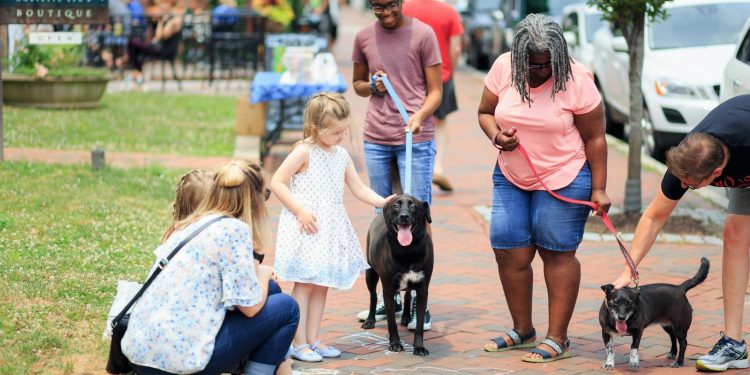Socializing your dog is one of the most important aspects of raising a well-adjusted, happy pet. Proper socialization involves introducing your dog to a variety of experiences, people, environments, and other animals in a positive way, helping them become confident and comfortable in different situations. Whether you have a young puppy or an older dog who missed out on early socialization, it’s never too late to begin. This guide will walk you through the process of socializing your dog effectively and help you understand why it’s so crucial for their overall development.
Why Socialization is Important
Dogs are social animals by nature, and their ability to interact positively with the world around them is largely shaped by their experiences during early developmental stages. Proper socialization helps prevent fear, anxiety, and aggressive behaviors that can develop from unfamiliar situations. A well-socialized dog is more likely to feel relaxed in different environments, interact well with strangers and other animals, and adapt more easily to new experiences.
Without socialization, dogs can become fearful or aggressive, which may lead to challenging behaviors and limit their ability to enjoy normal activities like walking in the park, visiting friends, or even going to the vet. By investing time in socializing your dog, you are helping to ensure that they are comfortable, well-behaved, and happy throughout their life.
Start Early: The Ideal Socialization Period
For puppies, the ideal socialization window is between three and fourteen weeks of age. During this time, puppies are most receptive to new experiences, and positive exposure can have a lasting impact on their personality and confidence. If you have a young puppy, start socializing them as soon as possible, taking care to expose them to a wide variety of people, places, sounds, and experiences.
If you have an older dog, don’t worry—it’s still possible to socialize them, although it may take a bit more time and patience. Older dogs may be more cautious, but gradual and positive exposure to new situations can still help them develop confidence and reduce anxiety.
Step 1: Introduce Your Dog to Different People
One of the key aspects of socialization is introducing your dog to a variety of people. This should include people of different ages, sizes, and appearances. Have your dog meet men, women, children, people wearing hats, people with glasses, and even people in uniforms. The goal is to help your dog understand that people come in all shapes and sizes, and that they are not a threat.
When introducing your dog to someone new, make sure the interaction is calm and positive. Let your dog approach the person at their own pace, and give them plenty of praise and treats for showing curiosity and calm behavior. Avoid forcing your dog to interact if they seem scared; instead, give them time and space to observe from a distance until they feel comfortable.
Step 2: Expose Your Dog to New Environments
Dogs that are only accustomed to one environment can become anxious when taken somewhere new. It’s important to expose your dog to a variety of environments, such as busy streets, parks, beaches, and even different houses or buildings. The more places your dog experiences, the more confident they will be in new settings.
When visiting a new place, make sure you remain calm and relaxed, as your dog will take cues from your behavior. Keep the visits short initially, gradually increasing the time as your dog becomes more comfortable. Always reward calm behavior with treats, praise, or playtime to help reinforce positive associations with new environments.
Step 3: Introduce Your Dog to Other Animals
Learning to interact appropriately with other dogs and animals is a critical component of socialization. Start by arranging playdates with other dogs that you know are friendly and well-socialized. It’s best to begin with one-on-one interactions in a controlled environment rather than jumping straight into a dog park, where the number of unfamiliar dogs can be overwhelming.
Watch your dog’s body language during interactions. Loose, wagging tails and a relaxed posture indicate that your dog is comfortable. If your dog shows signs of fear or aggression, such as a stiff body, raised hackles, or growling, it’s best to give them a break and try again another time. Make sure all interactions are supervised to prevent negative experiences that could set back your dog’s progress.
In addition to other dogs, try introducing your dog to other animals like cats, birds, or livestock (if possible). Again, make sure these interactions are controlled and safe, and reward calm behavior.
Step 4: Gradually Introduce New Sounds
Dogs can be sensitive to new or loud sounds, such as thunderstorms, fireworks, or sirens. Gradually introducing your dog to different sounds at a low volume can help them become accustomed to these noises without fear. There are many soundtracks available online specifically designed for desensitizing dogs to common household and environmental noises.
Start by playing the sounds at a low volume while offering treats and praise. If your dog remains calm, gradually increase the volume over time. The goal is to help your dog associate these sounds with positive experiences, rather than something to be scared of. Never force your dog to endure a sound if they are visibly scared—it’s always best to take things slowly.
Step 5: Handle Different Objects and Situations
Socialization also involves helping your dog become comfortable with various objects and situations. Expose your dog to items like umbrellas, bicycles, wheelchairs, or vacuum cleaners. Practice walking them near strollers, scooters, or people using walking sticks.
Encourage your dog to explore these items at their own pace, and reward them for approaching and investigating. The more your dog becomes accustomed to seeing and interacting with different objects, the less likely they will be to react fearfully when they encounter them later in life.
Step 6: Use Positive Reinforcement
Positive reinforcement is crucial throughout the socialization process. Whenever your dog reacts calmly or shows curiosity towards a new person, place, or experience, reward them with treats, praise, or play. Positive reinforcement helps create a positive association with new experiences, making your dog more likely to respond calmly in the future.
Avoid forcing your dog into situations that make them uncomfortable. The goal is to create positive, enjoyable experiences that build your dog’s confidence, not to overwhelm them. If your dog seems fearful, take a step back and allow them to proceed at their own pace.
Step 7: Gradually Increase Complexity
As your dog becomes more comfortable, gradually increase the complexity of their socialization experiences. If they have successfully met individuals in quiet settings, try introducing them to larger groups of people. If they’re comfortable in a quiet park, try taking them to a busier one. The gradual progression helps your dog adjust without becoming overwhelmed.
Each dog is different, and it’s important to move at a pace that suits their comfort level. Some dogs will adapt quickly, while others may need more time to adjust. The key is to be patient and celebrate each small victory along the way.
Step 8: Puppy Classes and Group Training
If you have a young puppy, consider enrolling them in a puppy socialization class. Puppy classes are a fantastic way for young dogs to interact with other puppies in a safe, structured environment. These classes also help with basic training and provide an opportunity for you to learn more about handling different behaviors.
If you have an older dog, group training classes can also be beneficial. These classes provide controlled socialization opportunities with other dogs, as well as valuable guidance from experienced trainers.
Step 9: Observe Body Language and Respect Boundaries
Understanding your dog’s body language is crucial for successful socialization. Watch for signs that your dog is feeling comfortable or, conversely, signs that they are feeling stressed. Relaxed ears, soft eyes, and a wagging tail typically indicate that your dog is comfortable. On the other hand, tucked tails, yawning, lip licking, or attempting to move away may indicate that your dog is feeling overwhelmed.
Respect your dog’s boundaries—if they seem uncomfortable or stressed, remove them from the situation and give them space to relax. Pushing your dog too quickly can lead to setbacks in their socialization progress.
Step 10: Make Socialization a Lifelong Process
Socialization isn’t something that ends once your dog reaches a certain age. It should be an ongoing process throughout your dog’s life. Regularly exposing your dog to new experiences helps reinforce their social skills and keeps them well-adjusted. Continue taking your dog to new places, introducing them to new people, and keeping their experiences varied and positive.
Remember, socialization is about creating positive associations. With patience, consistency, and positive reinforcement, you can help your dog become a confident, happy, and well-adjusted member of the family. By investing time in socialization, you’re helping your dog live a richer, more fulfilling life, and strengthening the bond you share with them.









Discussion about this post